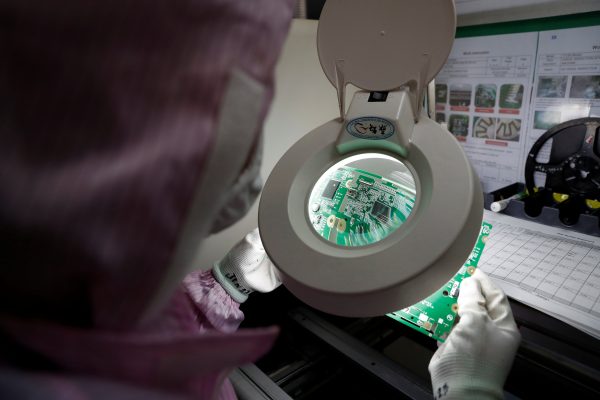But innovation’s promise to deliver superior economic performance and development outcomes remains elusive. The Philippines seems perennially stuck in the middle-income trap, facing some of the worst poverty and inequality in the region.
Key innovation-related development measures such as domestic value added (DVA) and total production output in high technology sectors are revealing.
The Philippines is the only country among the ASEAN-6 nations (Brunei, Indonesia, Malaysia, the Philippines, Singapore and Thailand) whose DVA in its gross exports failed to reach US$100 billion in 2018, garnering only US$60 billion. Vietnam overtook the Philippines in its share of regional DVA in 2018, despite starting at the bottom in 2000. Low DVA suggests that domestic firms do not have the necessary innovation capabilities for higher value-added production.
Total production output in high-technology sectors in the Philippines is dominated by multinational corporations (MNCs). This reveals that much of the value in key high-tech sectors — which helped the Philippines achieve a higher ranking in the GII — is created by MNCs rather than domestic firms.
MNCs often engage in low value-added activities that take advantage of the host economy’s lower labour and production costs rather than its knowledge outputs for higher value-added activities. This is most evident in the Philippines’ top high-technology export sector in electronics, where most activity is still dominated by MNCs in low-value assembly and test functions.
Why is this a problem? The limitations of domestic production and innovation capabilities to generate higher value-added goods and services are often why developing countries fail to move beyond the middle-income trap, an endemic problem in Southeast Asia and Africa. In contrast, the build-up of innovation capabilities in latecomer firms has been credited with leading successful cases of catch-up development, such as in South Korea.
Countries must reduce their reliance on foreign technology, management and know-how over time, and strengthen domestic firms’ capabilities to create and capture economic value.
The building of such capabilities is usually supported by a country’s innovation system — the interactions between firms and supporting institutions like universities, public research institutes and policymaking bodies. As in many developing countries, the Philippine innovation system can be characterised as the emergent type — some components are missing and the links between components are weak. Both quantitative and qualitative assessments of the Philippine innovation system find that while system components are marginally improving in terms of capability, the linkages between firms and public innovation system components — critical for innovation to spur development — are almost non-existent.
Limited industry-specific empirical studies, such as that of the local cacao chocolate industry, show that a lack of high-quality networks between public innovation system components and private firms led to policy interventions counterproductive to industrial upgrading. The interventions focused on global value chain (GVC) integration, rather than knowledge networks, as a solution for technological learning, which benefitted low value-added domestic cacao production for foreign chocolate manufacturing. But it also hindered the industry from participating in higher value-added fine flavour cacao production and domestic craft chocolate manufacturing.
High-quality networks need to be actively nurtured through meaningful public and private coordination and consultation. Partnerships between public innovation system components, like industrial development and science and technology organisations, and private innovation system components, such as local industries, are necessary in designing and implementing appropriate policy interventions.
Hazards that may come with strong public–private relationships in the Philippines, such as regulatory capture and cronyism, can be addressed through innovative institutional devices. For example, the East Asian tigers (South Korea, Taiwan, Singapore and Hong Kong) achieved close public–private relationships while mitigating hazards through the creation of deliberation councils to increase representation and transparency, while also instituting performance targets and sunset clauses in public support mechanisms.
Too often, countries adopt general innovation policies, like research and development (R&D) incentives or GVC integration, rather than firm-specific support because they do not understand how innovation occurs in specific sectoral contexts. Different firms have different levels of capabilities that can upgrade through different types of learning mechanisms, which consequently require different types of policy interventions. Building linkages enables policymakers to track the levels of production and innovation capabilities in domestic firms and provide targeted support.
Under such an approach the focus of innovation policy is upgrading domestic firm capabilities, which is what allows innovation to spur development. The role of Taiwan’s Industrial Development Bureau in building its specialised glass industry is an instructive example.
The Philippines is on the right track. It is currently building supply-side components for the country’s innovation system. The Department of Trade and Industry’s Regional Inclusive Innovation Centres and the Department of Science and Technology’s Science for Change programs aim to supply innovation system components, such as public R&D organisations, FabLabs, incubators and funding organisations.
The Philippine Innovation Act, signed in April 2019, institutionalises innovation at the heart of the country’s development strategy. Driving this strategy is the newly formed National Innovation Council, another critical innovation system component.
To boost development, the Philippines should focus on strengthening the quality of networks between IS components and adopting a capabilities-based approach to its innovation policy. These two challenges explain why the Philippines underperforms in key development metrics despite its relatively high innovation index ranking.
Kristoffer Daniel Tan Li is a postgraduate student at the National Graduate Institute for Policy Studies (GRIPS), Tokyo.

